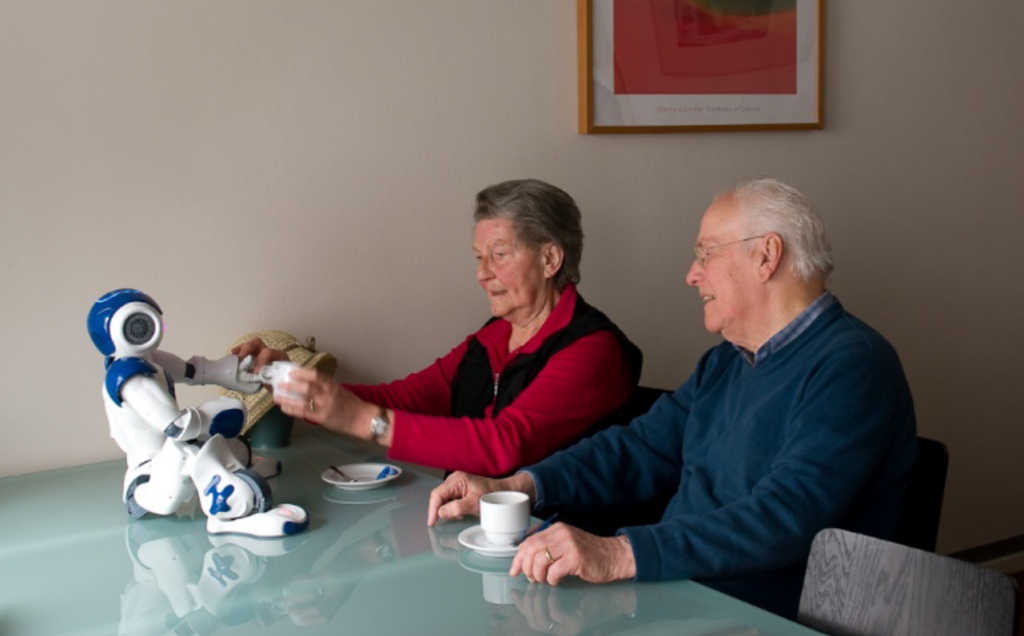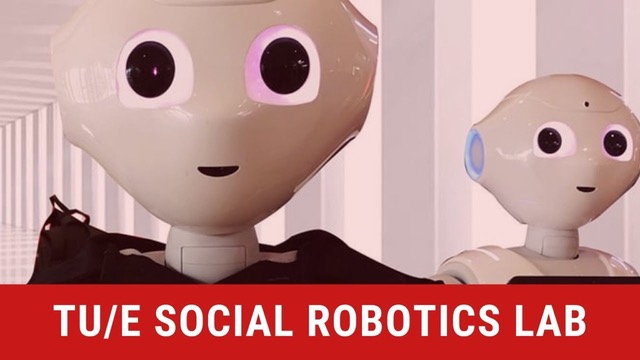Written by: Annemieke Groenenboom
In the face of a shortage of healthcare staff, older adults are increasingly compelled to maintain their independence for as long as possible. Technological innovations within the home setting have become indispensable for achieving this goal. However, the challenge lies in making them accessible to the elderly demographic and understanding the necessary requirements. Raymond Cuijpers (TU/e) is at the forefront of developing social robots, while Pol Grootswagers (WUR) is delving into the realm of healthy aging. In their quest for solutions, they eagerly seek to integrate insights from psychologists and sociologists.

Why are social robots the ultimate form of technological innovation for the home?
Social robots revolutionise human interaction in unprecedented ways. They possess the ability to comprehend non-verbal communication cues such as intonations and facial expressions and can actively apply these skills. This unique capability enables them to effectively engage with vulnerable groups, such as the elderly. Unlike current systems like wearables, which require Wi-Fi connectivity and carrying a device, a social robot seamlessly blends into the daily living environment.
What implications does this hold for the independence of older individuals?
Social robots can assume various administrative roles, from managing schedules to medication reminders. They can inquire about one’s well-being, monitor the health status of the elderly, and even raise alarms when necessary—all with a warm smile and infinite patience, 24/7. This not only benefits the elderly but also provides invaluable support to caregivers and healthcare professionals. Partners can confidently run errands, while caregivers receive real-time updates, enabling swift intervention if required.

Surprisingly, older adults are not only open to the idea of using robots but also appreciate the continuous support they provide. While robots do not replace healthcare professionals, they are becoming integral to the caregiving process. Future caregivers are likely to visit occasionally, delegating tasks related to monitoring and reminders to these robotic companions. Interestingly, seniors may sometimes prefer the company of a robot over a human caregiver. For example, in Japan, robots are already assisting the elderly with tasks, such as going to the bathroom, where privacy and anonymity are highly valued.
So, where do we stand currently in the development of social robots, and what is needed to drive further progress?
We find ourselves at the cusp of introducing prototype 3 to the market. These robots can perform a multitude of tasks, but there remain areas for refinement and enhancement. There is still a need for specific software and hardware components, as well as a deeper understanding of human behaviour. The existing software can only address needs in predefined categories and is yet to provide fully customisable solutions.

Furthermore, the absence of cost-effective hardware that can be left unattended with frail elderly individuals is a significant challenge. We must diligently adhere to stringent safety measures. For instance, robots may not fall and pose no risk to delicate fingers. Presently, many robots are tabletop models that are not suitable for approaching people or for providing them physical support. A more ideal solution would be a robot with legs, but currently, this is too fragile and economically unviable. Our goal is to ensure that these robots do not exceed a maximum cost of 5000 euros and become commercially accessible below 2000 euros. We hold hope that tech giants like Google, Apple, Microsoft, Amazon and Asus will invest in advanced robotic technologies.
Another crucial aspect that warrants improvement is the ability of robots to appropriately respond to human emotions. While these robots can recognise emotions, the challenge lies in how they should respond, for example when someone is feeling sad. Should they empathise and display sorrow, or should they exude positivity? We do not have sufficient understanding of human emotions to programme robots in the right way and there is currently no available database to train neural networks for this purpose.
How can other researchers contribute?
We would like to learn more about how knowledge about human behaviour can be turned into algorithms for robots. At the moment, we primarily need sociologists and psychologists who are technical, or technologists who know about psychology. For instance, how do you determine who has the floor in a group conversation? By looking at each other at the right moment. We can replicate these behaviours in a robot so that you genuinely feel like it’s listening and participating in the discussion. Such an example shows that psychology and technology are inextricably linked.

How can older adults stay healthy and independent for as long as possible?
Preserving muscle strength is a paramount factor in ensuring older adults can continue to lead independent lives. It empowers them to perform everyday tasks, such as grocery shopping, unaided. Moreover, maintaining sufficient muscle strength can significantly reduce the risks associated with post-operative recovery, particularly for planned surgeries where individuals can undergo pre-surgery training and incorporate additional protein intake into their diets. Regular physical activity is an effective preventive measure against numerous health issues that seniors may encounter, such as the risk of falls and broken bones.

It’s crucial to note that these recommendations are not exclusive to seniors. Ageing is a continuous process that can start as early as your 30s. Therefore, it would be beneficial for individuals of all age groups to engage in annual discussions with their general practitioners well before reaching the age of 60. These conversations could encompass various aspects of health, including nutrition, exercise, and mental well-being. Subsequently, tailored lifestyle guidance can be offered to address specific needs and goals.
How can technological innovations support these objectives?
Technologies and artificial intelligence are facilitating broader access to health and fitness programs for seniors, effectively reaching a larger demographic with fewer resources. For instance, consider our ongoing research on strength training in older adults, where we provide exercise and nutrition programs online. Participants engage in exercises at home, following instructions on their tablets. Their experience is not only enjoyable but also results in enhanced muscle strength. Moreover, this approach significantly lowers the barriers to participation. Our comprehensive program extends to include online consultations with dietitians and e-learning modules focusing on protein consumption.
In addition to exercise and nutrition, we harness the power of technologies to measure biological age through epigenetics. This innovative approach allows us to assess individuals’ biological ages, which can differ from their chronological ages. Such discrepancies provide invaluable insights into the health of different population groups and offer clues to the secrets of healthy aging.
I anticipate a substantial surge in the utilisation of technologies, primarily due to the evolving demographics of the senior population. While we often envision seniors struggling with technology, a considerable number of individuals aged 65 to 70 are tech-savvy. This presents a wealth of opportunities for technological integration.
How can other researchers contribute to your research?
As a physiologist investigating the intricacies of the human body, I am eager to gain deeper insights into the behavioural aspects of older individuals—particularly their dietary habits. What do they eat, and how can we make a healthy lifestyle more appealing to them? While I often collaborate with colleagues from WUR specialising in behaviour change, psychologists may provide additional valuable perspectives.
I’m also eager to engage in dialogues with technologists: how can we harness technologies to ensure that healthy living remains not just a temporary endeavour but a lifelong pursuit filled with enjoyment? Additionally, how can we apply technology to better monitor behaviour? Currently, our reliance on food diaries is common, but there are likely more innovative approaches waiting to be explored. While I don’t have prior experience with social robots, I wonder if they could potentially assist with the exercises from our fitness programs in the future.
Want to be in touch with Raymond or Pol? Contact us!